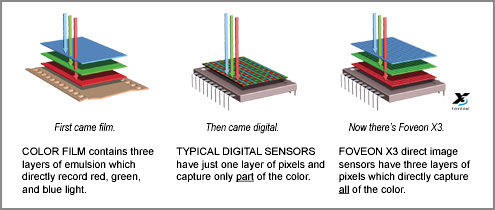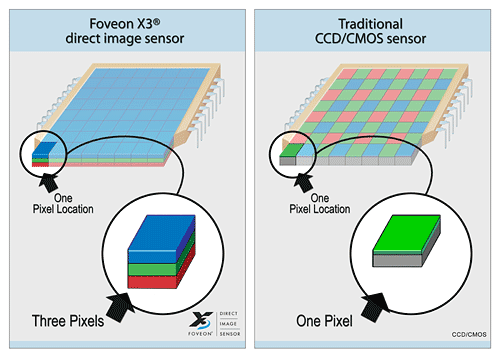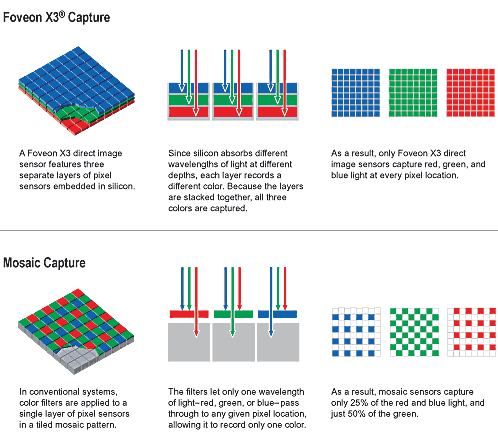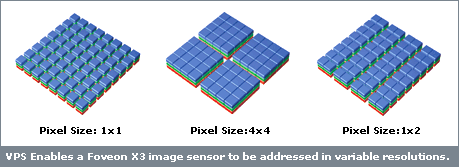Hybrid film and CCD / CMOS matrix is not possible? Try saying it Foveon X3!
- Transfer
Lyrical digression.
One interesting site caught my eye - www.foveon.com On it places information about the company Foveon is developing a three-chip systems (referred to more 3CCD) for digital cameras Sigma company Sigma Corporation . I was very surprised, both by the technology as a whole, and by the fact that so far there haven’t been any mention of this remarkable development on Habrahabr. All information is taken on the site.www.foveon.com
Image Sensors
The Foveon X3 is the most high-tech and advanced color direct image recording sensor that has ever been developed. Its development allowed to make a giant leap in digital photography, as The Foveon X3 sensor combines the advantages of both digital photosensors and the principles of saving the image of a conventional film.
The Foveon X3 Direct Image Sensor is an image sensor that can capture both red, green, and blue light at the same point in a single exposure. While working on the Foveon X3 sensors , a lot of research was done in the field of image acquisition using CCD / CMOS sensors and the principles of image acquisition using conventional film.

The first figure shows the principle of obtaining an image on a film. (The bottom line is that on a film, the registration of red, blue and green rays occurs at different depths, because after the light is refracted by the lens, the rays of the blue part of the spectrum will be focused closer to the surface of the film than the rays of the red part of the spectrum. That is, the red rays fall a little deeper in the thickness of the film, while the blue rays are focused almost at the surface itself. This spread is about 5 microns)
The second picture shows a clear diagram of the operation of a conventional CCD / CMOS Matrix. (Rays passing through the Bayer Filter are plotted ). Foveon X3
matrix is provided in the last image., and it is clearly illustrated how it combines the principles of operation of the CCD / CMOS matrix and film.
Film.
For more than 100 years, color film has been the gold standard in photography. It is the film that allows you to get natural warm tones, incredible detail and color reproduction, to which we are so used to. Photographic film allows to obtain such a result due to the presence of a three-layer structure (three layers of a photoemulsion, each of which is sensitive to a specific part of the spectrum, blue, green or red) in order to most fully capture all color tones at any point in the image.
CCD matrix.
The CCD matrix was developed about 30 years ago, but even at the peak of its development, it still does not make it possible to get the same colorful and detailed image as on film. This is due to the fact that at one point in time, CCD / CMOS digital image sensors are capable of detecting only one color at a single point in space.
Foveon x3
The developers of the Foveon X3 sensor combined the best of what was in the principles of recording images with film and a CCD / CMOS matrix. The result was a three-level Foveon X3 sensor. In structure, it is similar to film (contains three layers, each for recording the rays of its part of the spectrum), but instead of a photosensitive emulsion, in each layer of the three Foveon X3 sensorshas a matrix of pixels that register its part of the spectrum. Layers with pixels are arranged in such a way as to take advantage of the fact that red, green, and blue light are focused in a silicon matrix at different depths, which allows you to create one sensor sensitive to all three parts of the spectrum at the same point in the matrix. This made it possible to obtain a digital matrix that is capable of recording an image of the same quality and the same detail as a film could do.

Comparison of pixel locations in a conventional CCD / CMOS sensor and in a Foveon X3 sensor
Prior to the invention of the Foveon X3, the ratio between the number of pixels and the number of their locations was 1: 1 for a traditional CCD CMOS image sensor. Given these relationships, the generic term “pixel” was usually used to refer to both the pixel (photosensor) and its location in the matrix. Foveon x3- A new type of sensor that includes three pixels instead of one at each point in the image. Accordingly, the definition of the pixel itself is preserved, but now implies that the ratio between the number of pixels and the number of their location will correspond to 1: 3. This means that at one point in the image there will be not one pixel that is capable of registering only one third of the color information, as in a CCD / CMOS matrix, but as many as 3 pixels in different layers of the same matrix, which will provide a more complete color picture of the photographed image.

What is the better three-matrix system?
Why is the Foveon X3 three-matrix system so good ? And it is good in that three times as much area is used to register the same amount of light. After all, the Foveon X3 matrix essentially consists of three separate matrices located on top of each other:
- Blue - a thickness of 0.2 microns from the surface;
- Green - 0.4 microns thick;
- Red - the depth in the thickness of the crystal is more than 2 microns;
I allow myself to use the services of Wikipedia on this issue -

The thickness of each layer is selected according to the results of experimental studies on the penetration depth of quanta of the corresponding spectral range into silicon. The layers in which the photoelectric effect occurs are separated by additional thin zones of low-doped silicon and have separate signal outputs.
Due to the small (less than 5 microns) thickness of the sensor, the possible influence of chromatic aberration on the image is minimal. However, as in other types of matrices, the absorption of the red part of the spectrum occurs at maximum depth. As a result of parasitic diffusion of photoelectrons and exposure to oblique rays in the region of maximum wavelengths, additional image blurring occurs. In particular, this same effect makes it difficult to further (compared with current matrices) reduce the size of the element and increase the resolution.

If we consider the usual CCD / CMOS, knowing that the pixels in it are located in only one layer and one pixel can contain information about only one part of the spectrum, we can go so far that 50% of the pixels are in green (the highest sensitivity of the human eye is in the green part of the spectrum, so there are 2 times more green pixels), and blue and red each account for 25 percent of the total number of pixels. It turns out that not only does the usual CCD / CMOS matrix have a total area of all pixels two-thirds smaller, but also the number of pixels in a single color is even smaller relative to the total area of the matrix.
Step-by-step comparison of CCD / CMOS and Foveon X3 matrices
Here are two images:
from an ordinary camera with a CCD matrix and made by a camera with a Foveon X3 matrix.


The images show areas where we will compare the quality of work of both matrices.
Sharpness
CCD / CMOS matrix Foveon X3 matrix


Detailing colored objects
CCD / CMOS matrix Foveon X3 matrix


Artifacts
CCD / CMOS matrix Foveon X3 matrix


interactive demonstration of differences matrices CCD / CMOS from Foveon X3 .
Variable Pixel Size VPS
Foveon X3 has another interesting feature - it is able to change the pixel size (hereinafter, we will call this technology VPS). VPS technology opens up new horizons for camcorders and cameras in which they are installed. The uniqueness of the technology lies in the fact that the matrix can change its resolution by combining signals from several pixels into one, which makes it possible to perceive a group of pixels as one large pixel.
For example: a 2300 x 1500 pixel sensor contains approximately 3.4 million pixels. If we combine all the pixels in groups of 4 x 4 pixels using VPS technology, then in the end we would get a matrix of 575 x 375 pixels, but each of them would be 16 times larger than the nominal pixel. This would significantly increase the amount of light received by one pixel, and would inevitably lead to an increase in the sensitivity of the Foveon X3 matrix .
The most common possible pixel group configurations are:
- 2 x 2 pixels
- 4 x 4 pixels
- 1 x 2 pixels
Pixel groups are managed through a complex scheme integrated into the Foveon X3.
Because the Foveon X3 captures the entire portion of the visible range at each pixel location, the pixels in the combined groups are full-color “high quality pixels”. No other sensor can boast of such capabilities.

Interactive demonstration of VPS technology
Pixel grouping increases the Useful Signal / Noise ratio, allowing you to take full-color pictures in low light with minimal color distortion. Thanks to VPS technology, it has become possible to increase pixels, reducing their total number and resolution, but to get the opportunity to more quickly process frames of a video image, thereby increasing the speed of shooting video material.
This allows you to shoot more high-quality digital video, which in turn allows you to use two functions in one device - video shooting and photo shooting. Due to the fact that the rearrangement of pixels by VPS technology in Foveon X3 matrices happens instantly, it became possible to take instant photos right in the video mode without losing the quality of both modes.
Foveon X3 Working with Windows
Working with “windows” in Foveon X3 is that any rectangular area on the matrix is available to create a new image, because The technology allows you to have direct access to any rectangular area of an array of pixels.

CCD sensors, such a technology is not possible. because CCD technology does not initially support access to individual pixels or groups of pixels. At best, they offer a limited fixed set of possible cropping options for the finished image. With Foveon X3manufacturers of digital cameras are not limited by anything, which allows you to use the camera to obtain a new image by cutting out any rectangular area from the finished photo and saving it in a separate file. This allows you to give much more freedom to the end user when working with a camera with a Foveon X3 sensor .
The main feature of Foveon X3 is the absence of artifacts when resizing images. each pixel stores full color information, unlike CCD matrices, in which a single pixel can store information about only one color.
Thanks to VPS technology, metering can now be carried out more accurately in any light condition, as the matrix at the time of exposure metering goes into a mode of increasing pixels, which leads to a significant increase in sensitivity. The same function allows for faster focusing, mono-zonal exposure metering and many other things that are inaccessible to cameras with conventional CCD matrices.
X3 Fill Light - lighting correction function.

The first photo is the original image, the second is the image after the correction of lighting using X3 Fill Light technology.
The bottom line is the new X3 Fill Light technology automatically fixes lighting problems in digital photos.
If the photo was underexposed (for some reason), then the X3 Fill Light function will help to correct the situation. X3 Fill Light software works by modulating the natural environment for normal exposure. That is, artificially highlighted components are added while maintaining the same ratio of brightness and contrast of the main image array.
X3 Fill Light technology allows you to avoid the occurrence of unevenly bleached areas, thoroughly adjusting the parameters of each pixel relative to other pixels surrounding it. To work with images, the Foveon X3 processor generates an X3F file, which is then processed by X3 Fill Light software on a personal computer.
As a result, if the photo was taken erroneously at a slow shutter speed, or due to the bright background lighting it turned out darker than I wanted, there is always the opportunity to correct the error using the X3 Fill Light function and continue to enjoy high-quality images.
Thanks for attention!
